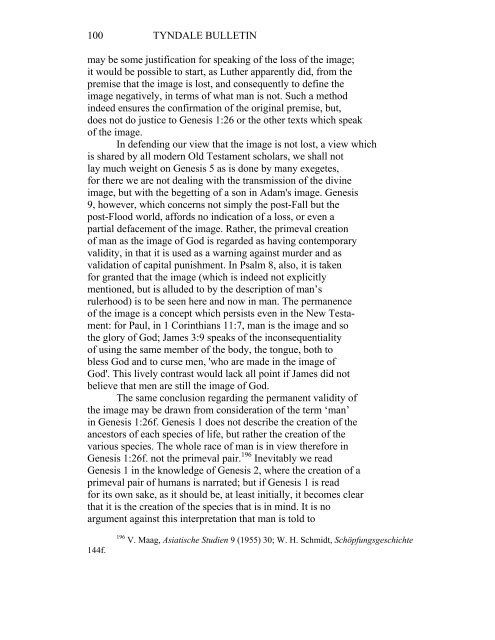THE IMAGE OF GOD IN MAN - Tyndale House
THE IMAGE OF GOD IN MAN - Tyndale House
THE IMAGE OF GOD IN MAN - Tyndale House
- TAGS
- tyndale
- tyndalehouse.com
Create successful ePaper yourself
Turn your PDF publications into a flip-book with our unique Google optimized e-Paper software.
100 TYNDALE BULLET<strong>IN</strong><br />
may be some justification for speaking of the loss of the image;<br />
it would be possible to start, as Luther apparently did, from the<br />
premise that the image is lost, and consequently to define the<br />
image negatively, in terms of what man is not. Such a method<br />
indeed ensures the confirmation of the original premise, but,<br />
does not do justice to Genesis 1:26 or the other texts which speak<br />
of the image.<br />
In defending our view that the image is not lost, a view which<br />
is shared by all modern Old Testament scholars, we shall not<br />
lay much weight on Genesis 5 as is done by many exegetes,<br />
for there we are not dealing with the transmission of the divine<br />
image, but with the begetting of a son in Adam's image. Genesis<br />
9, however, which concerns not simply the post-Fall but the<br />
post-Flood world, affords no indication of a loss, or even a<br />
partial defacement of the image. Rather, the primeval creation<br />
of man as the image of God is regarded as having contemporary<br />
validity, in that it is used as a warning against murder and as<br />
validation of capital punishment. In Psalm 8, also, it is taken<br />
for granted that the image (which is indeed not explicitly<br />
mentioned, but is alluded to by the description of man’s<br />
rulerhood) is to be seen here and now in man. The permanence<br />
of the image is a concept which persists even in the New Testa-<br />
ment: for Paul, in 1 Corinthians 11:7, man is the image and so<br />
the glory of God; James 3:9 speaks of the inconsequentiality<br />
of using the same member of the body, the tongue, both to<br />
bless God and to curse men, 'who are made in the image of<br />
God'. This lively contrast would lack all point if James did not<br />
believe that men are still the image of God.<br />
The same conclusion regarding the permanent validity of<br />
the image may be drawn from consideration of the term ‘man’<br />
in Genesis 1:26f. Genesis 1 does not describe the creation of the<br />
ancestors of each species of life, but rather the creation of the<br />
various species. The whole race of man is in view therefore in<br />
Genesis 1:26f. not the primeval pair. 196 Inevitably we read<br />
Genesis 1 in the knowledge of Genesis 2, where the creation of a<br />
primeval pair of humans is narrated; but if Genesis 1 is read<br />
for its own sake, as it should be, at least initially, it becomes clear<br />
that it is the creation of the species that is in mind. It is no<br />
argument against this interpretation that man is told to<br />
144f.<br />
196 V. Maag, Asiatische Studien 9 (1955) 30; W. H. Schmidt, Schöpfungsgeschichte

















